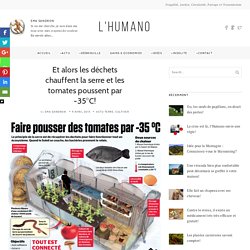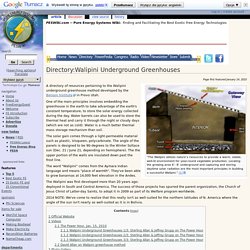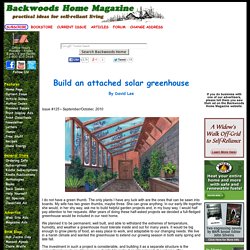

Timeline Photos - Rocket Stove Science. Et alors les déchets chauffent la serre et les tomates poussent par -35°C! Infographie via www.journaldemontreal.com Pour comprendre la méthode, voici une merveille >>> CLic Clic Clic Petite astuce pour zoomer : Poussez en même temps sur la touche Ctrl et faites bouger la roulette centrale de votre souris.

Sur le même thème Le Walipini? Oui, c'est une serre souterraine pour cultiver toute l'année! Terre - Social : Pour quelques 250 euros, il est possible de construire une serre souterraine qui vous permettra de jardiner toute l'année durant, malgré et au-delà du froid. 12 août 2013 Dans "Actu Sociale" Architecture mystérieuse : connaissez-vous la chaîne de Deï Man? Architecture - Mystère : Si vous aimez l'architecture ancienne, je suis ravie de pouvoir vous proposer grâce à Meta TV une vidéo exceptionnelle qui devrait vous captiver! 14 décembre 2015 Dans "Actu Mystérieuse" Le Walipini? Oui, c’est une serre souterraine pour cultiver toute l’année! Terre – Social : Pour quelques 250 euros, il est possible de construire une serre souterraine qui vous permettra de jardiner toute l’année durant, malgré et au-delà du froid.

Cette serre s’appelle un Walipini ou Walipinas. Le Walipini est une alternative abordable et efficace aux serres en verre. Tout d’abord développée il y a 20 ans pour les régions montagneuses froides d’Amérique du Sud, cette méthode permet aux agriculteurs du monde entier de maintenir un potager productif toute l’année, même lorsque le climat est froid. (src) © Benson Institute Si vous voulez en construire un, je vous propose un guide gratuit (PDF)>>> Clic Clic Clic En outre, j’ai trouvé un site très très très complet qui devraient répondre à beaucoup de questions. Il est en anglais mais vous pouvez traduire le texte en passant par Google Chrome ou par Firefox… Clic droit et traduction de la page. Voici une réalisation formidable en Bolivie. Directory:Walipini Underground Greenhouses. From PESWiki Page first featured January 14, 2010 "The Walipini utilizes nature’s resources to provide a warm, stable, well-lit environment for year-round vegetable production.

Locating the growing area 6’- 8’ underground and capturing and storing daytime solar radiation are the most important principles in building a successful Walipini. " [1] A directory of resources pertaining to the Walipini underground greenhouse mothod developed by the Benson Institute in Provo Utah. One of the main principles involves embedding the greenhouse in the earth to take advantage of the earth's constant temperature, to store the solar energy collected during the day.
The solar gain comes through a light-permeable material such as plastic, Visqueen, polycarbinate. The word "Walipini" comes from the Aymara Indian language and means "place of warmth". The Walipini was first developed more than 20 years ago; deployed in South and Central America. Official Website Videos The Power Hour, Jan. 15, 2010 Photo Gallery.
Photos de Pick-A-Pepper.com - Pick-A-Pepper.com. Build an attached solar greenhouse by David Lee. I do not have a green thumb.

The only plants I have any luck with are the ones that can be sawn into boards. My wife has two green thumbs, maybe three. She can grow anything. In our early life together she would, in her shy way, ask me to build helpful garden projects and, in my busy way, I would half pay attention to her requests. After years of doing these half-asked projects we decided a full-fledged greenhouse would be included in our next home. We planned it to be permanent, well built, and able to withstand the extremes of temperature, humidity, and weather a greenhouse must tolerate inside and out for many years. The investment in such a project is considerable, and building it as a separate structure is the conventional way to go.
We built ours 50 feet long and 9 feet wide, 450 square feet in area and about 3,000 cubic feet in volume. Ours is a solar greenhouse, and we live in the north country. In addition to food and heat, the quality of air in our house is healthier.